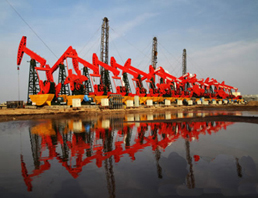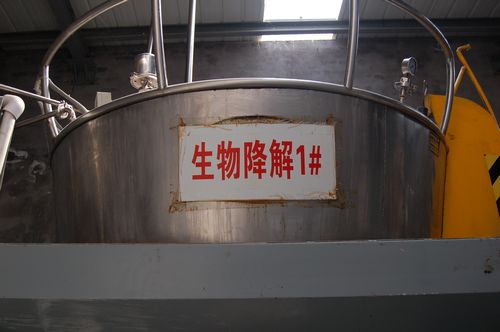- Home
- Products
-
-
Solids Control Equipment
- Linear Motion Shale Shaker
- Decanter Centrifuge
- Mud Cleaner
- Vacuum Degasser
- Centrifugal Pump
- Shear Pump
- Submersible Slurry Pump
- Mud Agitator
- Mud Gun
- Jet Mud Mixer
- Desilter
- Water Tank
- Mud Tank
- Diesel Tank
- MD210 Drilling Mud Cleaner
- Balanced Elliptical Motion Shale Shaker
- Oilfield Drilling Mud Desander
-
Solids Control System
- Drilling Mud Cooling System
- Solids Control System
- Mobile Solids Control System
- Arctic Solids Control System
-
TBM
- Tunnel Boring Mud System
-
HDD
- HDD Mud Recovery System
-
-
- News
- Services
- Marketing
- About Us
- Contact Us
- Videos
Home > KOSUN News >
Application of Biodegradation in Drilling Waste Management
Apr 18, 2012
READ: In drilling waste management, biodegradation has become one of the most favorable solutions among oil drilling companies at home and abroad due to its less expenses and the good environmental benefits it can achieve. However, different drilling environments mean...
In drilling waste management, biodegradation has become one of the most favorable solutions among oil drilling companies at home and abroad due to its less expenses and the good environmental benefits it can achieve. However, different drilling environments mean applications of biodegradation vary.

Field Picture of Oil Exploration
Biological drilling waste treatment describes degradation and mineralization of pollutants in drilling waste by bacteria growth, reproduction and internal respiration introduction of degrading bacteria and nutrients with the introduction of degrading bacteria and nutrients. It also takes advantage of biological characteristics in practical operations such as, liquid/solid separation by means of bios and degradation by means of adding microbial flocculant.

Field Picture of Biodegradation
However, the practicality of biodegradation must be taken into consideration based on the local environmental conditions before formally deciding upon this treatment approach. "Indigenous" microorganisms, nutrition factors, humidity, hydraulic detention time, PH value, dissolved oxygen should all be factored into consideration before the implementation of biodegradation.
“Indigenous” microorganisms are intrinsic microorganisms in drilling waste which do not need introduction and is comparatively economical, but is not effective in treatment. Nutrition factors play an important role in biological growth and metabolism. Therefore, drilling waste treatment needs appropriate addition of nutrition factors. Humidity is vital for biological growth and reproduction, but certainly of no significance for drilling fluids containing large amount of water. However, temperature should be kept under control. Minimized temperature is 15 degrees centigrade and the best is 30 degrees centigrade in drilling fluids treatment. Besides, for field operation of waste management, heating and insulation measures are needed for Winter and Spring and heating and cooling for Summer and Autumn. Hydraulic detention time defines how long treated wastewater stays in bioreactor. Organic pollutants in waste drilling fluids are, to a great extent, synthetic organic macromolecules which has a larger degradation rate than the other organic pollutants in wastewater, so the chosen bacteria should have better sludge loading ability. Above all, PH value and oxygen content of drilling fluids are also important factors and basic conditions for microorganisms to survive in drilling waste.
At present, the international waste treatment primarily adopts such approaches as land cultivation method, composting method, bioreactor, microbial flocculants method, anaerobic bio-treatment method, aerobic bio-treatment method, natural treatment method ( oxidation pond ).
Land cultivation method means to thoroughly degrade pollutants contained in drilling waste resorting to re-cultivation. It is very popular in many US and Russia drilling waste treatment sites, but it takes ages and costs a lot and is very easily affected by environment. Compositing method mainly degrades organisms by diluting drilling waste and then adding nutrients and sawdusts to attract microorganisms, which however truly is time-consuming. Bioreactor is both costly and energy-consuming since diluted and blended drilling waste and nutrient solution are put into certain tuner for adjustment of the survival factors for microorganism in order to achieve biodegradation. Microbial flocculants method makes good use of the principles of organic flocculants to solidify drilling fluids and degrade during the process. Apart from these, some drilling companies also apply anaerobic bio-treatment method, aerobic bio-treatment method, natural treatment method ( oxidation pond ) to improve on biodegradation and get good achievements.
Key words:
KOSUN: Established in 1992 and headquartered in Xi’an China, Xi’an KOSUN Machinery Co., Ltd. ( KOSUN ) is among the first group of manufacturers of oil drilling high-frequence shale shakers, is a specialized centrifuge producer, the pioneer in the field of solids control in China, as well as an expert in drilling waste treatment. Its business scope mainly covers China mainland, Commonwealth of Independent States, North Africa and U.S.A..
Solids control equipment: Its performance and quality play an important role in solids control technology. Drilling solids control system mainly contains such three parts as drilling fluids circulating tank, drilling fluids purification equipment and electric control equipment, among which the drilling fluids purification equipment includes shale shaker, desander, desilter, degasser, centrifuge, centrifugal pump, agitator, mixer, etc. Cuttings recovery and waste fluids treatment equipment can also be coupled for the environmental sensitive areas.


